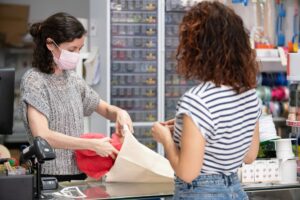The period of self-containment, businesses shuttering, and isolation may be just a short blip in the grand scheme of things, but as the pandemic continues to linger on through the end of the year, its impact cannot be ignored. The effects of empty shelves without toilet paper, fears of pathogens in the supermarkets, and the disappearance of preferred retailers will likely have an enduring effect on how and where people shop, as well as what they buy. These shifting consumer patterns are not necessarily negative, but companies will need to be aware of these changing shopper expectations and adapt their strategies to accommodate them.
One such omnichannel strategy is Buy Online Pickup In-Store (BOPIS) in retail, a COVID-19-conscious shopping method that promotes minimal contact, convenience, and safety among customers and employees.
BOPIS Retail: Covid-19 Is Changing Consumer Behaviors
America’s adoption of new shopping technology has accelerated like never before. It’s as if we’ve “covered a decade in days,” says McKinsey. Consumers are trying new features like Buy Online Pickup In-Store out of both necessity and preference—and they’re liking it.
Shopkick has been following the changes in consumer behaviors since the coronavirus crisis hit our country in March. While some shopping trends have waxed and waned, many have held consistent over the past six months. Here are some key trends we’ve observed.
People Still Love Brick-and-Mortar—A Lot.
Even if shoppers are buying online, they still like the in-store experience. Offering an omnichannel retail strategy like BOPIS ensures you appeal to every kind of shopper.
One would think the level of online shopping would skyrocket when stores are shutting their doors and health officials are advising to only go to stores for essential items only, but only 1 in 4 shoppers say they are making more online purchases as a result of the pandemic.
From March to April, the number of shoppers making one trip per week increased from 50% to 60%. However, by the summer months, 92% of shoppers ventured out at least once per week, and 42% shopped two times or more. This trend persisted through the Halloween shopping season, where 93% of shoppers preferred to buy their sweet treats in-store; nearly half of consumers went to big-box stores to pick up their costumes and decor as well.
If shoppers can’t find what they want in stock, 41% will try another brand that’s available rather than go to another store. Despite this growing willingness to venture outside of core brands, shoppers still overwhelmingly like being able to evaluate what’s available, compare prices, and pick items for themselves.
Big-Box Retailers Convert More Shoppers With All-In-One Shopping.
Most shoppers prefer big-box shopping. They likely trust big name brands like Walmart, Kroger, and Target to do what’s right to keep people safe. They also enjoy the convenience of being able to find everything they need—from pantry staples to back-to-school items—all in one place. Back-to-school shoppers indicated that saving money on supplies was a chief concern. New categories like furniture, technology, and personal hygiene led spending this year and drove many shoppers to stores that had all of these items available for purchase in one location.
Shopkick’s survey found that supermarkets captured 72% of in-store shoppers (which is expected from a necessity standpoint), but trailing very close behind were big-box retailers capturing 69% of in-store shoppers (likely for their all-in-one convenience model). BOPIS allows even greater convenience, particularly when big-box stores align online and offline inventory. This transparency provides a sense of assurance in customers, letting them know that whether they decide to shop in-store or online, they’ll have access to the products they want and need.
Buy Online Pickup In-Store Wins Big.
Nearly 70% of consumers say they will take advantage of BOPIS if available. This trend was already in development before COVID-19, with 86% of retailers saying they thought BOPIS was the future of retail in a survey conducted last year. For the upcoming 2020 holiday shopping season, only 17% of consumers say they will not be taking advantage of BOPIS this year.
The good news is that BOPIS shopping not only frees companies from the costly pressure of offering free shipping or same-day delivery service, but it also encourages 85% of shoppers to make additional in-store purchases.
Dick’s Sporting Goods is a brand that benefitted significantly from BOPIS retail during the COVID-19 pandemic. They posted their best-ever second quarter (+20.7%), even while 15% of their stores were closed to the public. Dick’s Sporting Goods pivoted to use their shuttered shops as distribution centers to cope with surging online sales from people stuck at home and wanting to buy new workout gear. Management has said they believe BOPIS is here to stay—not just for safety, but for convenience, just as fast-food restaurants utilize drive-thru services.
Key Shopping Seasons Are Lasting Longer Than Usual.
Uncertainty surrounding back-to-school shopping led to a prolonged season that started in late August and went well into September and even October. Most Halloween shoppers bought their candy in early October, which is standard, but holiday shoppers are planning to have most of their gifts bought before Black Friday this year—a major departure from years past.
Events like Amazon Prime Day and the new 10.10 Shopping Festival in October encourage this trend of early buying, with hundreds of retailers announcing their holiday sales sooner than ever before. Some of this early shopping is fueled by fears of shipping delays, so adding BOPIS is one way for retailers to show consumers they understand this pain and are equipped to solve the problem with same-day pickup options.
Digital Serves as Critical Infrastructure.
As of the second quarter of 2020, 1 in 2 baby boomers had transitioned some of their brick-and-mortar spending online. However, given the proliferation of BOPIS retail, curbside pickup, and delivery verticals, it became clear that the shopping journey is increasingly initiated using technology, no matter where or how the items are ultimately procured.
We’ve seen this trend for some time, with 82% of shoppers deciding where to shop based on a “near me” mobile search and 57% of consumers checking for mobile coupons while in-store. Optimizing for eCommerce on smaller screens is now more critical than ever. Over half of website traffic comes from mobile devices these days, so even online shoppers are using smartphones to facilitate purchases. In-store pickup options appeal to the instant gratification desires of shoppers and save on the cost of last-mile deliveries for retailers.
Omnichannel shopping is here to stay. Retailers can no longer consider it as a “secondary” channel or a value “add-on.” Creating a seamless digital experience with the right payment infrastructure, inventory tracking system, and customer relationship management software is a necessity for any business that wishes to survive in the modern environment.
Promotions and Availability Motivate Consumers Beyond Brand and Price.
 The immediate satisfaction of taking products home same-day was the driving force for 49% of the people Shopkick surveyed. Deciding where to shop was based on distance from home and ease of shopping for 39% of shoppers, while safety precautions (22%), price (18%), and product assortment (17%) mattered, too.
The immediate satisfaction of taking products home same-day was the driving force for 49% of the people Shopkick surveyed. Deciding where to shop was based on distance from home and ease of shopping for 39% of shoppers, while safety precautions (22%), price (18%), and product assortment (17%) mattered, too.
The majority of consumers now (61%) consider themselves “moderately loyal,” though they also admit to trying new brands rather than going to a different store to find what they need. For brands, the next-most-important factors driving a sale were: product availability (30%), price (10%), and product assortment (9%). Specific promotions guided 41% of shoppers to try new brands.
Shopkick is a mobile app that boosts brand awareness, customer engagement, and sales by incentivizing users with points (“kicks”) wherever and whenever they shop. Kicks can be earned by browsing branded lookbook or video content at home or on-the-go, scanning product barcodes at-shelf, and making purchases online or in-store.
Partnering brands and retailers have seen great results from promotional campaigns developed on Shopkick’s mobile platform. During a busy summer season, Bomb Pop frozen treats received over 23 million impressions in 2 months, with 44% of shoppers first becoming aware of the product through Shopkick and 68% of buyers admitting they hadn’t thought to purchase the product before exposure to the mobile promotion.
Looking Ahead to Post-COVID-19 Retail Trends
Once this pandemic is behind us, there is no doubt that some trends and habits that formed during its prevalence will have long-term staying power.
Trying a few new brands, consolidating shopping trips, engaging with mobile promotions, and taking advantage of BOPIS retail options during COVID-19 are all currently trending consumer behaviors that are likely to become permanent fixtures in our world as we continue to move forward.
Does your omnichannel strategy incorporate the necessary components (like BOPIS retail) to attract COVID-19-impacted shoppers? A partnership with Shopkick will ensure you’re reaching new and existing customers in a way that meets their current needs. Contact us to get started on your first campaign or read more of our success stories.
Image courtesy of Beatriz Vera





